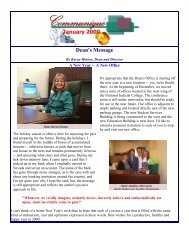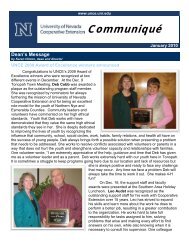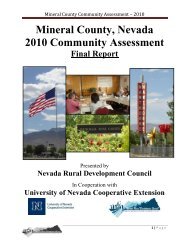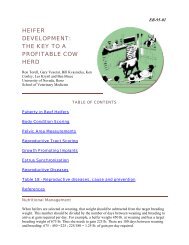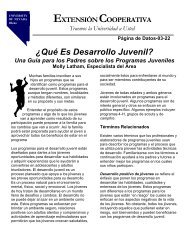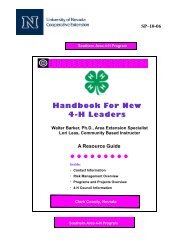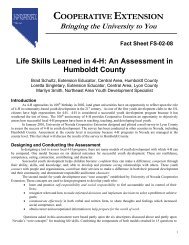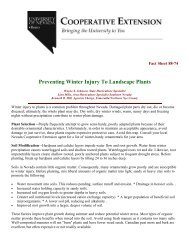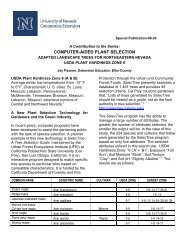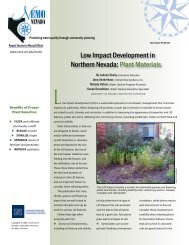Judging the Western Pleasure Horse - University of Nevada ...
Judging the Western Pleasure Horse - University of Nevada ...
Judging the Western Pleasure Horse - University of Nevada ...
You also want an ePaper? Increase the reach of your titles
YUMPU automatically turns print PDFs into web optimized ePapers that Google loves.
<strong>Judging</strong> <strong>the</strong> <strong>Western</strong><br />
<strong>Pleasure</strong> <strong>Horse</strong><br />
Al Cirelli, Jr., State <strong>Horse</strong> Specialist<br />
Brenda Cloud, Extension Assistant, Sou<strong>the</strong>rn Area<br />
Fact Sheet: 96-10<br />
Class Specifications:<br />
Introduction:<br />
The western pleasure horse class is judged on <strong>the</strong><br />
performance, conformation, and condition <strong>of</strong> <strong>the</strong> horse.<br />
A maximum <strong>of</strong> 80 percent is placed on performance.<br />
Conformation and condition are each scored a minimum<br />
10 percent.<br />
<strong>Western</strong> pleasure horses should move freely with a stride length that is appropriate to its<br />
conformation and structure. Movements <strong>of</strong> <strong>the</strong> horse should appear smooth and without<br />
effort. The horse should have a balanced, free-flowing motion. The head and neck<br />
should be in a normal and relaxed position. The poll should be level with or slightly<br />
above <strong>the</strong> level <strong>of</strong> <strong>the</strong> wi<strong>the</strong>rs. The face should not be carried behind <strong>the</strong> vertical,<br />
indicating possible intimidation, nor should it be excessively nosed out, as that gives <strong>the</strong><br />
appearance <strong>of</strong> resistance. The head should be level, nose slightly ahead <strong>of</strong> <strong>the</strong> vertical,<br />
with a pleasant expression and alert ears. The horse should work on a reasonably loose<br />
rein, with light and consistent contact. The horse should be willing and relaxed with a<br />
pleasant attitude and it should respond readily to all <strong>the</strong> riders cues. Transitions and<br />
extension or collection <strong>of</strong> <strong>the</strong> gaits should be smooth and <strong>the</strong> horse should move at an<br />
even pace. Stops and turns should be smooth, balanced and collected. Maximum credit<br />
should be given to <strong>the</strong> free moving, balanced, willing horse in good condition that<br />
appears to be pleasant to ride.
The following terms are used to describe <strong>the</strong> gaits in a western pleasure class.<br />
• Walk - A natural, flat-footed, lateral four beat, ground-covering gait. The walk<br />
should be energetic and alert. The stride should be <strong>of</strong> adequate length and is<br />
influenced by conformation and size <strong>of</strong> <strong>the</strong> horse. Movement at <strong>the</strong> walk should be<br />
free-flowing, straight, and true.<br />
• Jog - A two-beat diagonal gait with <strong>the</strong> horse working from one pair <strong>of</strong> diagonals to<br />
<strong>the</strong> o<strong>the</strong>r. The jog should be a ground-covering gait that is smooth, balanced, and<br />
straight. Knee action should not be high or over-flexed. <strong>Horse</strong>s walking behind and<br />
jogging in front are not performing <strong>the</strong> true gait. When extended <strong>the</strong> jog should be<br />
free and easy.<br />
• Lope - A free moving, natural three-beat gait that should appear smooth and<br />
relaxed. When going to <strong>the</strong> left, <strong>the</strong> horse should be on <strong>the</strong> left lead; when going to<br />
<strong>the</strong> right it should be on <strong>the</strong> right lead. <strong>Horse</strong>s moving in a four beat gait are not<br />
considered to be traveling in a correct lope. Speed should be at a natural rate for<br />
<strong>the</strong> lope.<br />
Note: "Beat" refers to <strong>the</strong> rhythmical progression or movement <strong>of</strong> <strong>the</strong> feet.<br />
Class Routine:<br />
• Walk, Jog, Lope - <strong>Horse</strong>s are shown at a three gaits on a reasonably loose rein,<br />
consistent contact, free <strong>of</strong> excessive restraint. They must work in both directions <strong>of</strong><br />
<strong>the</strong> arena.<br />
• Reversing - <strong>Horse</strong>s may only be reversed at <strong>the</strong> walk or jog. They can not be<br />
asked to reverse at <strong>the</strong> lope. <strong>Horse</strong>s are to be reversed to <strong>the</strong> inside (away from<br />
<strong>the</strong> rail).<br />
• Backing - Backing may only be for finalists at <strong>the</strong> discretion <strong>of</strong> <strong>the</strong> judge.<br />
The judge may ask for additional work, such as extension or collection <strong>of</strong> a gait, <strong>of</strong> <strong>the</strong><br />
same nature from any horse.<br />
Guidelines for <strong>Judging</strong>:<br />
Characteristic Good Minor Fault Major Fault Elimination<br />
Walk<br />
covers ground<br />
slow<br />
nervous<br />
not working<br />
flat-footed<br />
no interest<br />
jogging<br />
forward impulsion<br />
dull<br />
Jog<br />
smooth<br />
too slow/fast<br />
not two-beat<br />
breaks gait<br />
consistent<br />
rough, quick, choppy<br />
Lope<br />
smooth<br />
too slow/fast<br />
wrong lead<br />
not under control<br />
natural<br />
gaping
consistent<br />
pulling<br />
four-beat<br />
rough<br />
Extended Jog<br />
easy riding<br />
not consistent<br />
breaks gait<br />
not extended<br />
consistent<br />
pulls<br />
forward impulsion<br />
rough<br />
Backing<br />
straight<br />
hesitant<br />
throws head<br />
not backing/rears<br />
responsive<br />
gaps<br />
General<br />
smooth<br />
over flexed<br />
throws head<br />
constantly breaks gaits<br />
easy on rider<br />
under flexion<br />
gapping<br />
kicking<br />
sour ears<br />
bumps bit<br />
lameness<br />
tail switching<br />
bad mouth<br />
cueing in front <strong>of</strong> cinch<br />
not balanced<br />
stumbling<br />
fall <strong>of</strong> rider or horse<br />
touching horse or<br />
saddle with free hand<br />
ears below wi<strong>the</strong>rs<br />
head carried too low<br />
two hands on reins<br />
(except hackamore or<br />
snaffle)<br />
more than 1 finger<br />
between reins<br />
excessive nosing out<br />
illegal equipment<br />
References:<br />
United States Equestrian Federation (USEF) - Formerly: American <strong>Horse</strong> Show Association<br />
American Paint <strong>Horse</strong> Association<br />
American Quarter <strong>Horse</strong> Association.<br />
AQHA Official Handbook, 44th ed., 1996.<br />
UNIVERSITY<br />
OF<br />
NEVADA<br />
The <strong>University</strong> <strong>of</strong> <strong>Nevada</strong>, Reno is an Equal Opportunity/Affirmative Action employer and does not discriminate on <strong>the</strong> basis<br />
<strong>of</strong> race, color, religion, sex, age, creed, national origin, veteran status, physical or mental disability, or sexual orientation, in<br />
any program or activity it operates. The <strong>University</strong> <strong>of</strong> <strong>Nevada</strong> employs only United States Citizens and aliens lawfully<br />
authorized to work in <strong>the</strong> United States.



